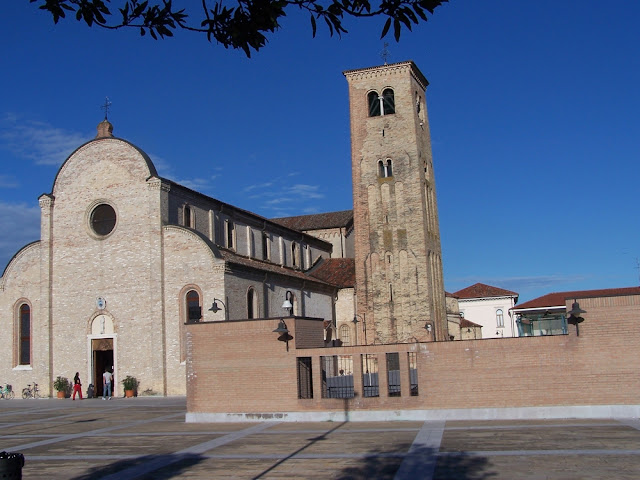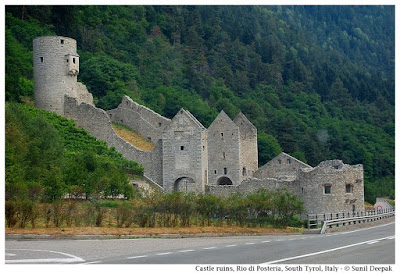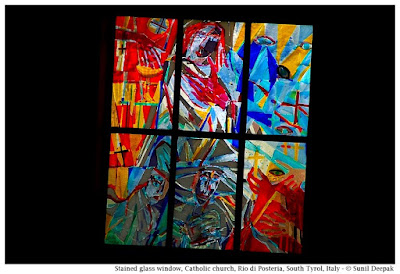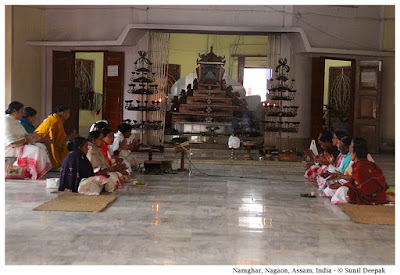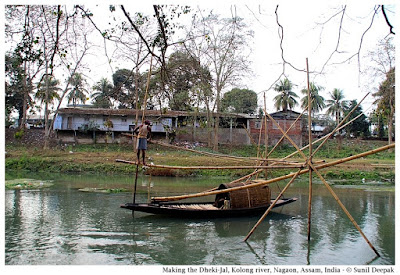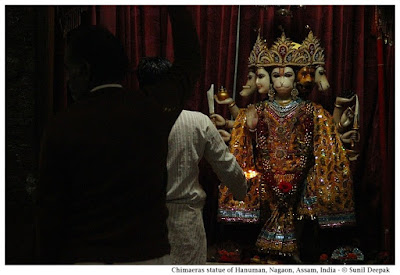Recently Cooperativa Trama organised a city walk to introduce the life and times of Almerico da Schio, known as the inventor of the first airship in Italy. Last year, I had visited the "Da Schio" family library, which has some precious manuscripts and written about the library as well as, about the first airship built by Almerico. This post focuses on some of the interesting things I learned from this city walk.
The image below is a street mural about Almerico in the city square dedicated to his name, built in the old lands of Da Schio family (click on the picture for a bigger view).
Before I start, a brief note - while Almerico's family used "Da Schio" (from Schio) as its family name, that appellation can also be added to persons from Schio, thus not all persons known as "da Schio" may necessarily belong to the family.
Da Schio family tombs at St Francis church
Our city walk started from this 13th century church of Schio, known for a beautiful painting of Francesco Verla and an old choir room made in wood at the back of its altar. This was an opportunity to talk about the family of Almerico.
Da Schio has been an important family in Schio since around 1500s when they had received the noble title of Count from the emperor. Almerico was born in 1836 in one of the family homes in Costozza, about 50 km from Schio. Some of the Da Schio family members are buried inside the St Francis church, where their tombs are located right in front of the altar, which can be recognised by the family coat-of-arms, which includes an imperial eagle and a two tailed mermaid.
It may have started as a humbler farming family and the earliest records are from 11-12th centuries. They owned all the farming land starting from the right and front of Schio's Duomo church in the city centre, up to the St Francis church and parts of Valletta.
One of the first well-known persons from the family was a Dominican priest in 13th century, Fr Giovanni da Schio. Another important person in the family was Girolamo da Schio (also known as G. Bencucci) in the 16 century, who was close to different popes and had become the bishop of Vaison in France, who was responsible for the nobility title of this family. Terracotta busts of both these persons can be seen the Jaquard gardens of Schio.
Almerico's father was a well-known archaeologist and had a beautiful Gothic house in Corso Palladio in Vicenza, Ca d'Oro. Almerico became famous for making the first airship in Italy, which had its first flight in Schio in 1905.
The Football Arena in Valletta
The family was also involved in construction of a sports arena in a natural depression called Valletta near the St Francis church in 1852, which had stairs around it for people to sit and watch football matches. Different personalities of Schio of that period, including Alessandro Rossi, Giovanni da Schio and Clemente Fusinato contributed funds to make the area oval-shaped and to build the stairs. Unfortunately, part of those stairs collapsed and some persons were injured. Those stairs were later removed, but the place with the depression, denoting the area still exists and used for play. The old print of the sports arena below is from Schio Cultura. In it, you can see Schio's Duomo church in the background (click on the image for a bigger view)
Schio's poet, Arnaldo Fusinato was also there to watch a match and later, he wrote a poem about playing football, titled, "Un impressione autunnale", in which a ball hit him on the face and he lost of one of his teeth.
The Family Arch near St. Mary Chapel
All this area was farm-land of the Da Schio family, and was known as "Brolo del signor Conte".
The road coming down from the Castel-hill and going towards St. Francis was separated from the farm by a wall on both sides, part of which can be seen in the old photograph on the signboard near the St Mary chapel from 1400s.
Near the chapel, there was the old water spring called Gaminella, water from which went into Gaminella canal today mostly hidden under Via Gaminella, except for a tiny bit close to the chapel. There was a time, when this canal ended in a lake in this area.
An arch built during 1700s still remains from the old wall. If you look carefully, you can see the coat of arms with twin-tailed mermaid and the words F.S. for the Da Schio family on the arch. The arch has two pyramid-shaped decorations resting on round stones on the sides. Some years ago, a professor noticed that there are Latin words written on the arch. These words are mostly family recommendations to the people, such as, "One who asks will receive and who knocks on the door, it will be opened", "Stealers remain always poor",and, "Don't take loan if you can't pay". The image below shows the arch.
Later, part of Da Schio family building in front of Duomo church was demolished to create Via Capitano Sella.
Almerico and Meteorology
Almerico studied law but he was not interested in that subject. He had interest in mathematics, astronomy, science and photography. While studying law in Padua, he had been an assistant to well-known astronomer Prof. Virgilio Trettenero. In those years, this part of Italy was under Austria and Almerico took part in cavort liberation and resistance activities.
His first job was as the director of the meteorological centre of Olympic Academy of Vicenza, which had one observatory. He recognised that this new discipline needed better understanding and decided to care observation centres in all the province. Over a period of next 20 years, he would help in creating 200 observation centres to study temperatures, rains, storms, etc., including in neighbouring regions, including one of the first centres in Schio in 1873, located on his own land (Image below shows the family gate with the twin-tailed siren from the coat of arms and the area where the meteorological centre was located) .
Bringing together all the data he had collected, he contributed to the foundation of national centre of meteorology. Development of this discipline also contributed to development of more precise measuring instruments.
The study of weather patterns was very useful for agriculture, including their own farm production. He helped his brother, engaged in agriculture in Costozza to start a new activity, growing cave-mushrooms.
Almerico's Collaborators & Friends
Different persons collaborated with him on this. In Schio, his administrator Matteo Manea and his wife Minimina, were tasked with daily checking and noting the temperatures at specific times - 9 AM, 3 PM & 9 PM.
Almerico also wanted to create a centre for observing storms, for this he found a collaborator in Giovanni dal Pozzo, who was a tailor but who had a passion for astronomy and sciences. He was also a musician, playing Viola and a poet in the local dialect of Schio, and had translated an opera, Oralando Furioso, in the dialect. He had a big family and his wife had died. He also started a tavern called Osteria Cantarana, to earn some more money, on Almerico's land in the area near Via Baratto. Almerico helped him to get good wines for this tavern.
Giovanni and Almerico became friends. Almerico wrote a booklet about instruments used for meteorological observations and in this mentioned the work of Giovanni.
Another friend of Almerico was Don Francesco Faccin, a local priest born in 1871, who was interested in astronomy. Schio's astronomical observatory located on Monte Novegno is named after Don Faccin and there is a city street in his name. Almerico wrote to Queen Margherita, to ask for a telescope for Don Faccin and this request was accepted by the queen.
Another collaborator of Almerico was Giacomo Moracchioli who lived in Via Fusinato, in front of the church dedicated to St. Bakhita. He was a historian and interested in astronomy. He was in charge of the meteorological centre of Schio. He had build an observation tower on his roof. Both Almerico and Giacomo were passionate about mountains, and were part of the group which had created the Alpine group of Schio, which later became part of CAI-Vicenza (Italian Alpine Club) and introduced the importance of scientific study of the mountains.
Schio's Aqueduct
One of Almerico's most important contributions to Schio was the construction of city's water supply though an aqueduct. The idea of bringing water from surrounding mountains started being discussed in 1870s, because the city had grown and industries had polluted the local water sources. A priest called Don Michele Saccardo started the campaign for the aqueduct.
The first study on how to make an aqueduct was paid by Alessandro Rossi. This project proposed bringing water from the area of Poleo in cast iron pipes, but was considered too costly. A second project with stone-tubes was proposed, which reduced the cost a little but it was still considered too much.
Then Don Saccardo spoke to Almerico, who came up with a third project, which was approved by the municipal authorities but they didn't have the funds to cover all its cost. Almerico asked the citizens to make donations for building the aqueduct. About 100 families were promised that water-pines will come to their homes, while there will be public taps in 14 locations of the city.
The fund-collection was successful and the aqueduct was inaugurated on 18 June 1872, with a fountain with a nymph and a 27 metres high water-jet in front of Duomo. (Image show a painting belonging to Angela Rossi showing the aqueduct inauguration)
In Conclusion
Almerico da Schio had played an important role in carrying forward the ideas of scientific knowledge in 19th-20th centuries in different fields, especially astronomy, meteorology and air-ships. Italy's queen Margherita had come to Schio on 1 July 1905 to see one of his flights.
This post, based on a walking tour organised by Cooperativa Trama in 2025, focuses on some aspects of Almerico's life.
You can also check my post from 2024, in which I had written about Almerico's airship and the old books in his family's library in Schio.
***










